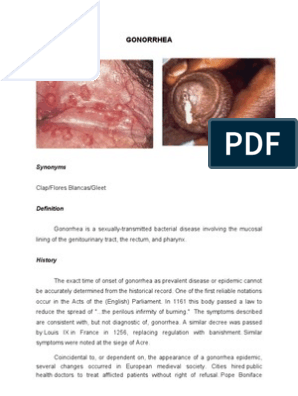0% found this document useful (0 votes)
41 views7 pagesGonorrhea
Gonorrhea is a sexually transmitted infection caused by the bacterium Neisseria gonorrhoeae. It is commonly spread through unprotected vaginal, oral, or anal sex. While symptoms usually appear within 2-14 days, some people never develop symptoms or remain asymptomatic carriers. Gonorrhea can affect the genitals, rectum, throat, eyes, and bloodstream. Risk factors include having multiple sex partners, unprotected sex, substance abuse, and a prior history of gonorrhea infection.
Uploaded by
aterbat07Copyright
© © All Rights Reserved
We take content rights seriously. If you suspect this is your content, claim it here.
Available Formats
Download as DOC, PDF, TXT or read online on Scribd
0% found this document useful (0 votes)
41 views7 pagesGonorrhea
Gonorrhea is a sexually transmitted infection caused by the bacterium Neisseria gonorrhoeae. It is commonly spread through unprotected vaginal, oral, or anal sex. While symptoms usually appear within 2-14 days, some people never develop symptoms or remain asymptomatic carriers. Gonorrhea can affect the genitals, rectum, throat, eyes, and bloodstream. Risk factors include having multiple sex partners, unprotected sex, substance abuse, and a prior history of gonorrhea infection.
Uploaded by
aterbat07Copyright
© © All Rights Reserved
We take content rights seriously. If you suspect this is your content, claim it here.
Available Formats
Download as DOC, PDF, TXT or read online on Scribd
/ 7


















































































